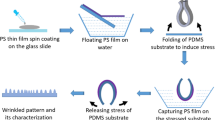Abstract
Wrinkling and buckling of nano-films on the compliant substrate are always induced due to thermal deformation mismatch. This paper proposes effective means to control the surface wrinkling of thin film on the compliant substrate, which exploits the curvatures of the curve cracks designed on the stiff film. The procedures of the method are summarized as: 1) curve patterns are fabricated on the surface of PDMS (Polydimethylsiloxane) substrate and then the aluminum film with the thickness of several hundred nano-meters is deposited on the substrate; 2) the curve patterns are transferred onto the aluminum film and lead to cracking of the film along the curves. The cracking redistributes the stress in the compressed film on the substrate; 3) on the concave side of the curve, the wrinkling of the film surface is suppressed to be identified as shielding effect and on the convex side the wrinkling of the film surface is induced to be identified as inductive effect. The shielding and inductive effects make the dis-ordered wrinkling and buckling controllable. This phenomenon provides a potential application in the fabrication of flexible electronic devices.
Similar content being viewed by others
References
Miller A F. Materials science: Exploiting wrinkle formation. Science, 2007, 317(5838): 605–606
Bowden N, Huck W, Paul K, et al. The controlled formation of ordered sinusoidal structures by plasma oxidation of an elastomeric polymer. Appl Phys Lett, 1999, 75(17): 2557–2559
Chung J Y, Nolte A J, Stafford C M. Surface wrinkling: A versatile platform for measuring thin-film properties. Adv Mater, 2011, 23(3): 349–368
Genzer J, Groenewold J. Soft matter with hard skin: From skin wrinkles to templating and material characterization. Soft Matter, 2006, 2(4): 310–323
Gruner P, Arlt M, Fuhrmann-Lieker T. Surface wrinkling induced by photofluidization of low molecular azo glasses. Chem Phys Chem, 2013, 14(2): 424–430
Bowden N, Brittain S, Evans A, et al. Spontaneous formation of ordered structures in thin films of metals supported on an elastomeric polymer. Nature, 1998, 393(6681): 146–149
Yoo P, Suh K, Kang H, et al. Polymer elasticity-driven wrinkling and coarsening in high temperature buckling of metal-capped polymer thin films. Phys Rev Lett, 2004, 93(3): 034301
Feng X, Yang B D, Liu Y M, et al. Stretchable ferroelectric nanoribbons with wavy configurations on elastomeric substrates. ACS Nano, 2011, 5(4): 3326–3332
Song J, Jiang H, Liu Z J, et al. Buckling of a stiff thin film on a compliant substrate in large deformation. Int J Solids Struct, 2008, 45(10): 3107–3121
Yu C, Pan Y, Ma H, et al. Thermoresponsiveness of integrated ultra-thin silicon with poly(N-isopropylacrylamide) hydrogels. Macromol Rapid Commun, 2011, 32(11): 820–824
Lam M T, Clem W C, Takayama S. Reversible on-demand cell alignment using reconfigurable microtopography. Biomaterials, 2008, 29(11): 1705–1712
Xuan Y, Guo X, Cui Y, et al. Crack-free controlled wrinkling of a bilayer film with a gradient interface. Soft Matter, 2012, 8(37): 9603–9609
Rogers J A, Someya T, Huang Y. Materials and mechanics for stretchable electronics. Science, 2010, 327(5973): 1603–1607
Chan E P, Crosby A J. Fabricating microlens arrays by surface wrinkling. Adv Mater, 2006, 18(24): 3238–3242
Okayasu T, Zhang H L, Bucknall D G. Spontaneous formation of ordered lateral patterns in polymer thin-film structures. Adv Funct Mater, 2004, 14(11): 1081–1088
Schweikart A, Fery A. Controlled wrinkling as a novel method for the fabrication of patterned surfaces. Microchim Acta, 2009, 165(3–4): 249–263
Chan E P, Crosby A J. Spontaneous formation of stable aligned wrinkling patterns. Soft Matter, 2006, 2(4): 324–328
Uchida N, Ohzono T. Orientational ordering of buckling-induced microwrinkles on soft substrates. Soft Matter, 2010, 6(22): 5729–5735
Wu D, Yin Y J, Xie H M. The archimedes spiral cracks developed in the nano-film/substrate system. Chin Phys Lett, 2013, 30(3): 036801
Chan E P, Crosby A J. Fabricating microlens arrays by surface wrinkling. Adv Mater, 2006, 18: 3238–3242
Author information
Authors and Affiliations
Corresponding author
Rights and permissions
About this article
Cite this article
Wu, D., Yin, Y., Xie, H. et al. Controlling the surface buckling wrinkles by patterning the material system of hard-nano-film/soft-matter-substrate. Sci. China Phys. Mech. Astron. 57, 637–643 (2014). https://doi.org/10.1007/s11433-014-5391-7
Received:
Accepted:
Published:
Issue Date:
DOI: https://doi.org/10.1007/s11433-014-5391-7




